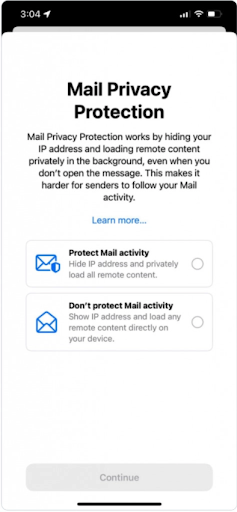What Apple’s Mail Privacy Protection Means for Nonprofits


On September 20, 2021, Apple launched its much-talked-about Mail Privacy Protection – an adjustment to the Apple Mail application that can alter your nonprofit email marketing strategy.
So, let’s review what’s changed, what it means, and, more importantly, how you can navigate Apple’s Mail Privacy Protection in your email communications and fundraising campaigns.
What is Apple’s Mail Privacy Protection Policy?
In recent years, email marketing has become an essential facet of online marketing strategies, allowing both for-profit companies and nonprofit organizations to connect with their clients, donors, and constituents on a more personal level. The impact of email marketing has proven to be deeply effective, boosting online awareness and engagement.
And for a long time, email marketers could gather engagement data about their email campaigns by inserting invisible pixels into the email body. This way, when emails are open, and these pixels are loaded, the email host can detect that the email has been opened, the device type used to open it, and the recipient’s IP address, which gives an approximate location usually limited to the recipient’s city.
However, with Apple’s mail privacy protection policy, email marketers are no longer able to track these data points and may come up against a few other challenges.
Specifically, the policy states that:
“Mail Privacy Protection stops senders from using invisible pixels to collect information about the user. The new feature helps users prevent senders from knowing when they open an email and masks their IP address so it can’t be linked to other online activity or used to determine their location.”
This release is broken down into three main components:
1. Mail Privacy Protection
Free for all Apple Mail users; they now have the option of opting in to mail privacy features that block third-party users from collecting that engagement data. While it’s released now, you can expect most Apple users to have adopted this feature by early 2022.


In essence, when Apple Mail users opt in, this policy means:
- Open rates are no longer reliable email performance metrics
- Automated tasks triggered by available rates are now unnecessary in some circumstances
- Live content, such as countdown timers or thermometers for year-end fundraising is now inaccurate.
https://www.keela.co/blog/donor-communications/mailchimp-for-nonprofitsThis policy applies to all Apple Mail emails no matter who the provider is, whether it’s Keela, MailChimp, or Campaign Monitor. And it’s a substantial number. Apple users make up over 35% of the market around the world. In fact, in May 2021, of all the emails opened on mobile, 93.5% were opened in Apple Mail. On desktop, this number was 58.4%.
2. iCloud+
A paid iCloud subscription now comes with additional privacy features that prevent websites from tracking opted-in Safari users and allow those users to see which websites they’re sending information to.
3. Hide my Email
Also, within iCloud+, this final privacy measure is an address-cloaking feature. Users can give websites a “fake” email address. Don’t worry; the email still arrives in the user’s inbox, but the user is essentially using an online alias. Your organization will only know the user’s actual email address if they choose to share it with you.
Although this might seem intimidating, nonprofits constantly adapt their policies to meet new privacy regulations, website responsiveness requirements, and more. Plus, with more internet privacy rollouts expected from Google and other tech giants, there’s no reason why you won’t learn, adapt and thrive to these changes and future ones.
Identify and Track Your Nonprofit’s KPIs
Use this FREE Toolkit to learn what it means to be data-driven and get access to a master list of fundraising KPIs for your nonprofits.
How Nonprofit Email Marketers Can Adapt to Apple’s Mail Privacy Protection
In short, this policy severely impacts one key metric: Open Rates.
An open rate is an email marketing metric that tracks the percentage of recipients who opened the email sent. It allows nonprofits to assess the health and engagement of their subscription list.
Many marketers rely on Open Rate to determine the success of their email marketing efforts. It is used to determine the success of re-engagement campaigns, automated nurture flows, and send-time optimization campaigns.
With this new policy, email marketers can’t assess their email campaign performances accurately. But here are seven steps you can take to circumvent this and ensure your emails are being read, actioned, and your fundraising remains unimpacted:
1. Update Your Workflow Criteria
If your automated email workflow currently relies on an email being opened before delivering the next one in the flow, you may need to adjust this to rely on a specific time frame instead.
2. Track Alternative Email Metrics
Since open rates are no longer as accurate, organizations need to start relying on other metrics to assess their email campaign performance. Some email engagement metrics to consider include:
Ultimately, tracking multiple email metrics will allow you to supplement the data lost by the compromised open rate. The best practice for nonprofit organizations is to track activity across a diverse array of metrics to get a dynamic and overarching view of the success of your marketing efforts. In any marketing campaign, success should never rely solely on one metric, and tracking across multiple will provide deeper insight into the engagement of your contact list.
3. Explore New Channels
While email marketing will remain a viable fundraising channel for your nonprofit, this could be a good opportunity to check if the grass is greener on the other side. SMS marketing, Peer-to-Peer fundraising, or even an old-fashioned direct mail campaign could all prove to be excellent supplementary fundraising endeavors.
4. Determine your Nonprofit’s Best Time to Send Emails
While you can, and if you haven’t done so in a while, consider conducting A/B tests to determine the best time to send emails to your donors. This will boost the chance of donors and supporters’ chance to open and act on your emails.
5. Update Your Nonprofit’s Email List
Now’s the time to organize your nonprofit’s email lists and perform inactivity management practices. In other words, find out those recipients who aren’t engaging with your email and conduct a re-engagement campaign.
After the campaign, you may need to delete contacts who still aren’t engaging with your content. This step will help you better assess your email campaign performance and limit the chances of your emails getting tagged as spam in the future.
Plus, if you clean out bounced or unsubscribed emails either with a segment or by removing them altogether, you’ll be left with an engaged audience who knows and trusts you—making your end-of-year fundraising campaigns run so much smoother.
6. Collect Missing Data
As mentioned above, fundraisers and marketers no longer have access to where their constituents are located. Don’t see this as a hindrance. Instead, put your stewardship hat on. This is an excellent opportunity to reach out with a survey or other interactive methods to get the information you need on new and existing supporters.
You can always tell them it’s because of Apple’s privacy update. It’s likely they know what it is and may assume it doesn’t affect charities and nonprofits. Plus, the more information they give you, the better-tailored your campaigns will be. It’s a win-win for everyone.
7. Improve the Quality of Your Nonprofit’s Email Content
Finally, one of the best ways to ensure the success of your marketing efforts is to create personal, compelling email content. In essence, your donors will interact with the content they find most interesting, and the quality of your content should always take priority over the quantity and strategy (although all these pieces go hand in hand!).
Apple’s mail privacy protection can impact the way you communicate with your donors. But don’t fret; you can start making changes today to adapt to this new policy and ensure your donor relationships aren’t affected. For more email marketing best practices, check out Keela’s Ultimate Guide to Nonprofit Email Marketing.
Track the Email Metrics that Matter using Keela
Get a glimpse of how Keela helps nonprofit email marketers measure their email campaign performance and improve donor communications.
Apple’s mail privacy protection can impact the way you communicate with your donors. But don’t fret; you can start making changes today to adapt to this new policy and ensure your donor relationships aren’t affected.
For more email marketing best practices, check out Keela’s Ultimate Guide to Nonprofit Email Marketing.


